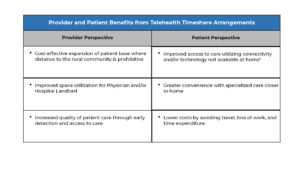Published as an MGMA Insight Article June 2020.
Telehealth has become increasingly more popular in recent years as hospitals implementing computerized telehealth systems grew from 35% to 76% based on an American Hospital Association survey.[1] The same growth has been seen outside of hospitals. Claims coming from non-hospital based telehealth services accounted for 84% of total claims in 2018 as compared to 52% in 2014.[2] Many rural health systems across the United States (US) have embraced this growth to improve patient access to specialized care. One tool in their toolbox has been to setup medical office timeshares for the expressed purpose of connecting patients remotely with health systems and/or physicians located in another city.
Telehealth Timeshare Arrangement: The Basics[3]
Ms. Adams is 20 weeks pregnant and comes to her primary OB/GYN physician and receives the news that her baby may have a congenital heart defect after having a recent ultrasound. As such, her OB/GYN refers her to a maternal fetal medicine (MFM) physician for on-going surveillance during the rest of her pregnancy. Unfortunately, the closest MFM is 4 hours away after the prior MFM stopped coming on a monthly basis.
Ms. Adams is amongst many who live in rural communities and are faced with needed specialty care. While rural communities are experiencing shortages in primary care with 39.8 primary care physicians per 100,000 people as compared to 53.3 primary care physicians per 100,000 in urban areas, the shortage is even more extreme when comparing specialists[4]. Traditional medical office timeshares rely on the physician tenant physically coming to the location to see patients during a specific time slot. However, while these physician tenants wish to expand their patient base as far as 2-5 hours away from their primary location, the expense associated with their time is resulting in specialists trying to find alternatives. Telehealth timeshares is one such alternative.
Telehealth medical office timeshare arrangements grew from these challenges with specialists in such areas as cardiovascular surgery, orthopedic surgery, maternal fetal medicine, and neurology, placing needed diagnostic equipment in these communities in order to assess, diagnose and establish treatment plans for patients remotely. Utilizing diagnostic equipment in the timeshare space at the patient’s location along with the necessary telehealth video conferencing equipment allows for simultaneous view of a high definition image of an ultrasound, x-ray, CT scan, or MRI with the physician tenant / specialist. In the case of Ms. Adams, she is able to have a remote consult with her MFM while both being able to visualize the ultrasound of her baby.
Benefits of a Telehealth Timeshare Arrangement
Utilizing telehealth through a timeshare arrangement provides multiple advantages for both the providers and patients. The Table below illustrates some of the benefits from these arrangements.

These benefits have been echoed through multiple surveys of providers and patients.[6],[7]
Key Components of Fair Market Value (FMV)
Hospitals and physician practices are subject to regulatory requirements under the federal law, a variety of state-specific fraud and abuse statutes, and governmental agencies when entering into a medical office timeshare arrangement. In order to navigate potential safe harbors and/or exceptions to these regulations, these timeshare agreements must be at FMV to ensure that there is no undue benefit provided to the physician tenant. In structuring a compliant agreement at FMV, there are key areas to examine: i. space, ii. furniture and equipment, iii. services, and iv. short-term use premiums.
Space- The space cost utilized for the telehealth visit needs to be determined based on a real estate appraisal providing the FMV full-service rental rate and an architect drawing defining the square footage subject to the arrangement. Common along with dedicated exclusive use areas need to be clearly demarcated in the calculation to ensure that the space utilization is calculated accurately. After the total square footage applicable to the tenant is identified (exclusive use square feet + allocated shared common area square feet), it is multiplied by the FMV full-service rental rate of the space determined by a real estate appraiser to ensure all building operating expenses are considered. Also, In the case of telehealth services, it will be important to consider the storage for the telehealth equipment during non-use. Should the equipment be stored at the landlord’s cost, this expense should be included in the lease payment.
Furniture and Equipment– Similar to the space analysis, the furniture and equipment utilized within the common and dedicated exclusive use areas need to be included. These could involve waiting room chairs, desks, tables, computer/office equipment, etc. Often under these telehealth arrangements, the physician tenant or local health system will own the diagnostic and/or remote telehealth equipment. If this is the case, the equipment cost that is not bore by the landlord can be excluded.
Services– There is variability in the specific services offered under these arrangements. These services can range from telecommunication, front desk receptionist, medical and office supplies, magazines, water and coffee supplies, among others. Also, under a telehealth arrangement, it is critical to understand the any clinical labor costs to provide the service. For instance, does the diagnostic test under the telehealth service require a specific staffing resource, such as a medical assistant, radiology technician, or registered nurse? Does the telehealth visit require this staff member to be present throughout a portion of the visit? The value needs to consider the extent that the staff member(s) are being utilized.
Short-term use premium– A major component often missing from the medical office timeshare value is a short-term use premium. In other industries, a premium is paid for the part-time use of space or services (i.e. conference room, executive office suite, rental car, hotel, equipment, etc.). Medical office timeshares are no exception; in fact, it’s essential to ensure compliance. This premium can be impacted by the number of tenant time-slots leased, the landlord utilization risk, and current market comparable transactions.
Key Compliance Takeaways
Telehealth has opened up an opportunity for specialists, located at a distance from patients in rural areas, to remotely care for patients in a cost-effective, efficient, and quality driven manner. It has also allowed the physician landlord to provide a convenience to their patient base needing this additional specialized care. COVID-19 has only accelerated this growth through regulatory waivers, increased telehealth funding, and the need to maintain patient volumes. To ensure the arrangement is compliant, each component must be calculated accurately and appropriately given the specific facts and circumstances of each arrangement. With well documented support, a medical office timeshare can be a great option to reach a larger patient base while increasing convenience and improved access to care for patients.
For more information on our medical office timeshare services, do not hesitate to contact us today.

[1] https://www.aha.org/system/files/2019-02/fact-sheet-telehealth-2-4-19.pdf
[2] A Multilayered Analysis of Telehealth: How this emerging venue of care is affecting the healthcare landscape. https://www.fairhealth.org/article/fair-health-research
[3] COVID-19 has resulted in numerous regulatory waivers that impact telehealth type of visits, place of service, and reimbursement during the state of emergency. The authors understand the potential impact of these waivers should they persist after the state of emergency. Contemplation of this fact is beyond the scope of this piece.
[4] National Rural Health Association; https://www.ruralhealthweb.org/about-nrha/about-rural-health-care
[5] 2020 Broadband Deployment Report. Federal Communications Commission. https://docs.fcc.gov/public/attachments/FCC-20-50A1.pdf
[6] Survey, FP Expert Agree: Interest in Telehealth on the Rise; https://www.aafp.org/news/practice-professional-issues/20190514telehealth.html
[7] Survey: Americans’ perceptions of telehealth in the COVID-19 era; https://www.healthcareitnews.com/news/survey-americans-perceptions-telehealth-covid-19-era


